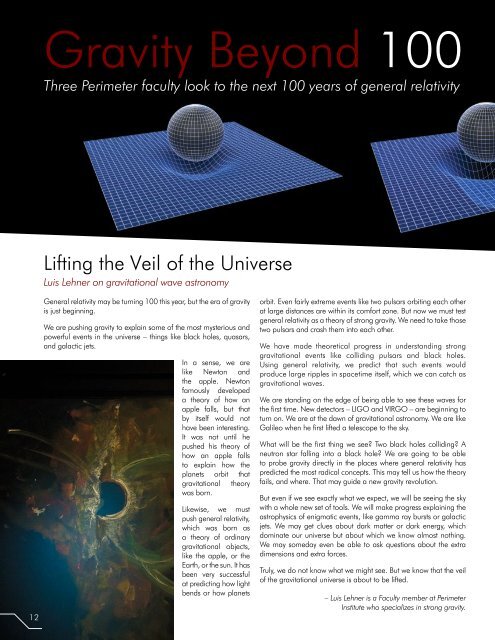the Perimeter
PI_Magazine_2015
PI_Magazine_2015
You also want an ePaper? Increase the reach of your titles
YUMPU automatically turns print PDFs into web optimized ePapers that Google loves.
Gravity Beyond 100<br />
Three <strong>Perimeter</strong> faculty look to <strong>the</strong> next 100 years of general relativity<br />
Lifting <strong>the</strong> Veil of <strong>the</strong> Universe<br />
Luis Lehner on gravitational wave astronomy<br />
12<br />
General relativity may be turning 100 this year, but <strong>the</strong> era of gravity<br />
is just beginning.<br />
We are pushing gravity to explain some of <strong>the</strong> most mysterious and<br />
powerful events in <strong>the</strong> universe – things like black holes, quasars,<br />
and galactic jets.<br />
In a sense, we are<br />
like Newton and<br />
<strong>the</strong> apple. Newton<br />
famously developed<br />
a <strong>the</strong>ory of how an<br />
apple falls, but that<br />
by itself would not<br />
have been interesting.<br />
It was not until he<br />
pushed his <strong>the</strong>ory of<br />
how an apple falls<br />
to explain how <strong>the</strong><br />
planets orbit that<br />
gravitational <strong>the</strong>ory<br />
was born.<br />
Likewise, we must<br />
push general relativity,<br />
which was born as<br />
a <strong>the</strong>ory of ordinary<br />
gravitational objects,<br />
like <strong>the</strong> apple, or <strong>the</strong><br />
Earth, or <strong>the</strong> sun. It has<br />
been very successful<br />
at predicting how light<br />
bends or how planets<br />
orbit. Even fairly extreme events like two pulsars orbiting each o<strong>the</strong>r<br />
at large distances are within its comfort zone. But now we must test<br />
general relativity as a <strong>the</strong>ory of strong gravity. We need to take those<br />
two pulsars and crash <strong>the</strong>m into each o<strong>the</strong>r.<br />
We have made <strong>the</strong>oretical progress in understanding strong<br />
gravitational events like colliding pulsars and black holes.<br />
Using general relativity, we predict that such events would<br />
produce large ripples in spacetime itself, which we can catch as<br />
gravitational waves.<br />
We are standing on <strong>the</strong> edge of being able to see <strong>the</strong>se waves for<br />
<strong>the</strong> first time. New detectors – LIGO and VIRGO – are beginning to<br />
turn on. We are at <strong>the</strong> dawn of gravitational astronomy. We are like<br />
Galileo when he first lifted a telescope to <strong>the</strong> sky.<br />
What will be <strong>the</strong> first thing we see? Two black holes colliding? A<br />
neutron star falling into a black hole? We are going to be able<br />
to probe gravity directly in <strong>the</strong> places where general relativity has<br />
predicted <strong>the</strong> most radical concepts. This may tell us how <strong>the</strong> <strong>the</strong>ory<br />
fails, and where. That may guide a new gravity revolution.<br />
But even if we see exactly what we expect, we will be seeing <strong>the</strong> sky<br />
with a whole new set of tools. We will make progress explaining <strong>the</strong><br />
astrophysics of enigmatic events, like gamma ray bursts or galactic<br />
jets. We may get clues about dark matter or dark energy, which<br />
dominate our universe but about which we know almost nothing.<br />
We may someday even be able to ask questions about <strong>the</strong> extra<br />
dimensions and extra forces.<br />
Truly, we do not know what we might see. But we know that <strong>the</strong> veil<br />
of <strong>the</strong> gravitational universe is about to be lifted.<br />
– Luis Lehner is a Faculty member at <strong>Perimeter</strong><br />
Institute who specializes in strong gravity.


